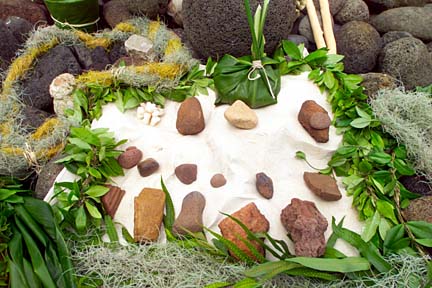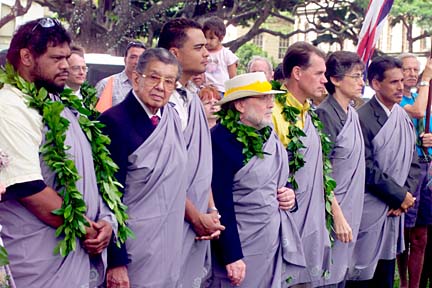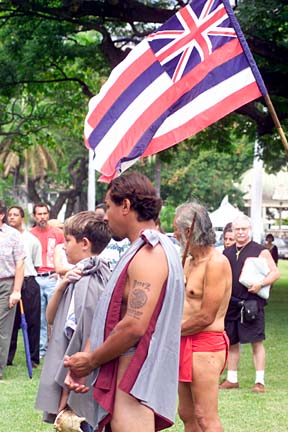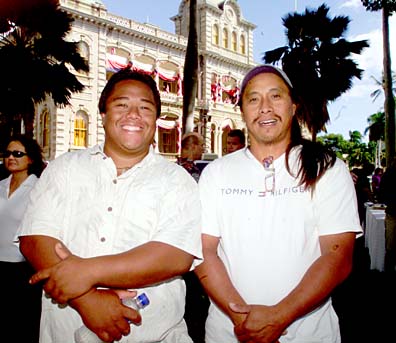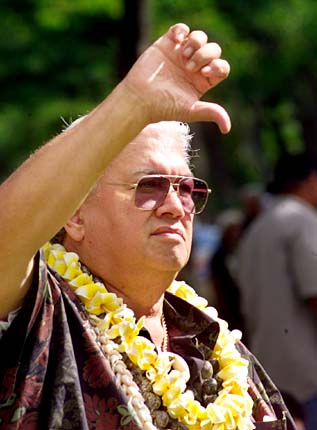
DENNIS ODA / DODA@STARBULLETIN.COM
Ceremonies on the Iolani Palace grounds yesterday commemorated the Navy's hand-over of Kahoolawe control to the state. After the cultural ceremony, Dr. Kekuni Blaisdell watched Leon Siu greet Kekama Galioto with honi, meaning to share one's breath.
Ceremony at palace
marks return of KahoolaweThe hand-over comes
10 years after the Navy
agreed to its return
Traditional Hawaiian music and offerings on the front lawn of Iolani Palace marked the passage of Kahoolawe to state control yesterday afternoon.
Since the Dec. 7, 1941, attack on Pearl Harbor, the U.S. Navy has controlled the 45-square-mile island, using it for target and bombing practice. The military forbade anyone from going on the island.
In 1990 the federal government agreed to stop the bombing and in 1993 agreed to return it to local control within 10 years. The island officially transferred to state control on Tuesday, but ceremonies were scheduled for yesterday to avoid Veterans Day conflicts.
Kahoolawe, once known as the "Target Island" and once called Kanaloa by native Hawaiians, has come to symbolize Hawaiian culture and pride.
George Helm, a musician and singer, and another activist, Kimo Mitchell, drowned in an ocean crossing while protesting the military use of Kahoolawe in 1977.
DENNIS ODA / DODA@STARBULLETIN.COM
The diverse audience applauded during the formal ceremony.
Yesterday, Larry Helm watched the ceremonies and thought of his brother.
"Because of Kahoolawe, Hawaiians had a focal point. It was a catalyst to raise issues when my brother was involved," Helm said. "Today, you have a lot of ancient Hawaiian dance. They are speaking Hawaiian in the schools. This isn't a Kodak Hula Show culture."
Former Gov. John Waihee, the first elected governor of native Hawaiian ancestry, told a crowd of about 300 yesterday that the return of Kahoolawe puts Hawaii on the "threshold of taking the last step to restore nationhood to the Hawaiian people."
"The cause is right and righteousness makes the meek bold," Waihee said.
The two-hour ceremony was not without protest. Some cultural groups carried signs decrying the military presence in the state, and some Hawaiian elders heckled speakers Adm. Walter Doran and Rear Adm. Barry McCullough, commander of Navy Region Hawaii, with thumbs-down gestures and shouts of "Stop the bombing."
DENNIS ODA / DODA@STARBULLETIN.COM
Hookupu, or offerings, were presented.
But Gov. Linda Lingle praised the Navy for the job it has done in clearing much of the bombs and scrap metal littering the island.
"The decisions that led to the bombing were made by people long gone," Lingle said. "The Navy with us today did its very best effort, and they deserve our respect and gratitude."
Access to Kahoolawe will be controlled by the Kahoolawe Island Reserve Commission, a state agency created to oversee the island, which is set aside by federal and state law for environmental restoration and cultural, education and archaeological activities.
Despite a 10-year, $460 million Navy cleanup effort that is scheduled to finish in March, about one-fourth of Kahoolawe has not been cleared of ordnance.
The Associated Press contributed to this report.
DENNIS ODA / DODA@STARBULLETIN.COM
Dignitaries attended the cultural ceremonies yesterday marking the U.S. Navy's hand-over of Kahoolawe to the state.
DENNIS ODA / DODA@STARBULLETIN.COM
The Hawaii state flag was proudly waved.
DENNIS ODA / DODA@STARBULLETIN.COM
Derek Mar Jr., left, and his father, Derek Sr., posed in front of Iolani Palace.
DENNIS ODA / DODA@STARBULLETIN.COM
Activist Charles Maxwell gestured his disapproval as Adm. Walter Doran spoke during the ceremony.


